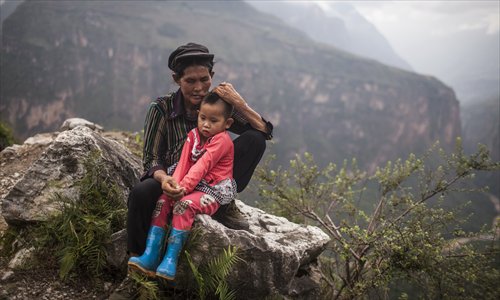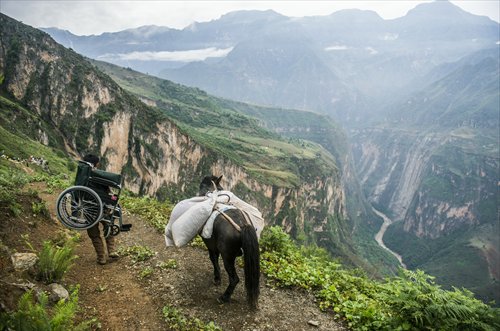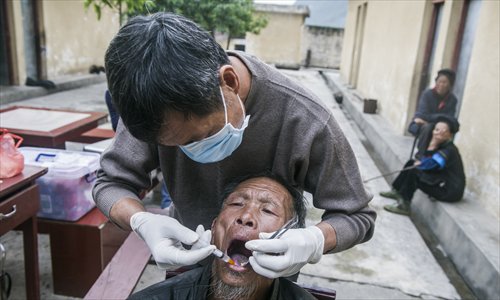Healthy descendants trapped in isolated leper colonies due to discrimination

Jierme Ciwai, 65, a leprosy sufferer, rests on a rock with one of her grandchildren in her arms in Abuluoha village, Butuo county, Liangshan Yi Autonomous Prefecture, Sichuan Province. Photo: Li Hao/GT
The only way to get to the village of Abuluoha is on foot - a four-hour trek via a single, steep cliff-side path just a meter across.
The village's inaccessibility is intentional: to the outside world, Abuluoha is a "leper village." And to many of those who populate the surrounding villages in Liangshan Yi Autonomous Prefecture in Sichuan Province, its inhabitants are pariahs.
About 200 people live in Abuluoha, among them only about 40 elders are leprosy sufferers who still bear the scars of affliction: a lost digit, a deformed limb. The rest 160 villagers are the second and third generations of former patients, and have never been infected.
It's one of more than 600 leper villages in China, most of which were created in the late 1950s and 1960s in mountainous areas.
In 1963, when Abuluoha was settled, leprosy was considered incurable and highly contagious. Quarantining sufferers meant sending them to high mountains or islets, to try to isolate the disease with natural barriers. Patients were banned from marriage or childbirth, and, aside from occasional deliveries of medicine, left to themselves.
Some died, others survived. Some broke the ban and raised children. For decades, these villages were nearly forgotten by outsiders, living primitively, free of any administrative rules.
By the 1980s, advances in multi-drug therapy meant that the bacillus capable of destroying skin, nerves and flesh could, with early diagnosis and treatment, be completely cured. Moreover, its contagious potential was proven a total myth: 95 percent of people have a natural immunity.
Yet the inhabitants of villages like Abuluoha remained in isolation. It has only been the intervention of NGOs, religious groups or volunteers in recent years that leper villages have opened to the public. Local governments took some actions, renovating houses, offering elderly and childless survivors basic living-allowances, building roads and relocating some villages.
Eliminating centuries-old prejudice has been another matter. The natural barriers may have mostly gone but the villagers, their children and grandchildren are still struggling to eliminate the social ones against them.

A villager from Abuluoha village carries a wheelchair for a leprosy sufferer, donated by charity groups to the village. Photo: Li Hao/GT
Toll of isolation
"Due to lifelong isolation, [the villagers'] concept of living, mind-set and language remains decades-old," Master Guoyan, the abbot of Qianfo Temple in Fushun county, told the Global Times. "They used to live together with livestock, with no toilets or hygiene habits."
Guoyan is the director of the Zhongyuanpuji Institute, a Buddhist charity which has worked since 2009 to help leper villages in Sichuan. Workers bring clothes and detergent, and lessons in how to use them. In Qianjin, a Yi ethnic village in Liangshan's Xide county, the villagers now raise pigs and cows in separate rooms, and wash their clothes regularly. But many other habits remain.
Despite the scorching sunlight, the enclosed rooms inside the white, newly painted houses were gloomy and humid, with furniture in disarray and beds unmade. Faeces - human and animal - litter the paths, along with garbage. The air hums with the buzz of flies. "This will take a long time," Guoyan admitted.
Nevertheless, in Guoyan's opinion, breaking down social barriers and dispelling discrimination is the greater challenge.
Xu Xianfeng, director of the Qingfeng Fukang Leprosy Project, an NGO funded from Hong Kong since 2005, agreed. Their attempts to introduce former leper to urban life have long been stymied by local authorities, she said. "They explained explicitly that the lepers are not allowed to enter the city," Xu recalled.
That's starting to change - slowly. Authorities have allowed more NGO activities and issued leper village residents with new hukou (household registration). Previously their hukou documents categorize them as leprosy villages.
The villages have new names but it's far from enough to wash away the taint of leprosy.

A volunteer doctor fixes teeth for a leprosy sufferer in Abuluoha. Photo: Li Hao/GT
A life worth living?
Though healthy and sound, villagers often suffer from discrimination simply for being a member of a leper village.
Asked about any prejudice they have suffered, the young men of Qianjin village raised their voices in unison.
"When walking past us, [residents from other villages] will make a detour to avoid getting close," complained Ashuo Wuhe, 35, in broken Mandarin.
Pointing to a mountain not far away, another young man spoke angrily. After translation by Bizhe, the village doctor, it was explained that a new house had been dismantled by villagers from the other side of the mountain.
Bizhe explained that the latter have formed a boundary of trees, warning the "lepers" that "they are not allowed to farm or build houses [there]."
Before 2008, they lived high up the mountain. Since 1958, leprosy patients were continuously sent to that camp, reaching a peak of some 300 in total.
As of today, about 90 have survived, with their children and grandchildren taking the village's population to 400. Their relocation met strong opposition, although the new Qianjin is still five kilometers away from the nearest village.
Village head Jiyi Muga, 50, squats on a bridge with his arms folded across. As his deformed hands show, he used to suffer from leprosy since he was 13.
"There's no resentment any more. It was the times," he said calmly.
Indeed, back then, it was common for families to abandon spouses, siblings, even children, once they were found with leprosy symptoms. Even after recovery, families would not accept them back. Further back, before 1949, villagers took much more brutal solutions, burning or burying alive lepers.
Today, there's still not much of a life for survivors. The healthy young men cannot seek manual jobs outside, as county employers reject them once they know that they are from Qianjin. Due to illiteracy and poor language skills, attempts to work outside the county are always met with failure.
With potatoes as the staple crop, the villagers mainly depend on cattle and pigs for income. According to Jiyi, the annual income per capita is no more than 1,000 yuan ($160).
Progress and hope
In some rural areas, particularly among seniors, there is a belief that any contact with lepers, their descendants, or even the tools or water supply they use would cause infection.
During our visit to Qianjin, four Christian volunteers from Shandong and Hebei provinces arrived, causing a stir: The village scarcely gets any visitors except charity workers. They brought a minivan of clothes and vegetables but the local driver stopped outside the village and refused to drive in.
An hour later, after much negotiation and persuasion, the driver agreed to bring the van in, quickly shutting the doors after the goods were unloaded and staying inside.
The villagers now place their greatest hope on the third generation. They are happy that the government has built primary schools in nearly every leper village. The family-planning policy never reached their borders and it's common to see families with four or more children.
"No matter how financially hard, I will try my best to send my children to study as far as they can," said Ashuo Wuhe, who has two sons and two daughters aged between 8 and 15.
Many, though, drop out. One major reason is that almost all secondary schools in the county decline to accept them.
But since 2011, at least one has. Thanks to years of lobbying local governments by Zhang Pingyi, a Taiwanese journalist-turned volunteer, Dayingpan School in Liangshan's Yuexi county has expanded and finally opened junior-high classes.
In Qianjin village, six children are studying outside the county, four in high school in Yuexi county and two in vocational schools in Chengdu, the provincial capital.
With 116 students in total, the Qianjin primary school now has 10 teachers, all from other places in the county.
In a clean bright classroom, kids delightedly talked of their dreams to be a teacher or doctor, while curiously asking questions of their own.
Asked about leprosy, they suddenly fell silent. "We are no different from all the other children in this world," Jiweng Azhi, 14, then muttered.
Charity worker Xu Xianfeng worried that outsiders' rejection might sow seeds of hatred in the hearts of these innocent children. "I once read a composition by a child from a leper village," Xu said. "The kid wrote that he wished to become a policeman and arrest all those who discriminated against them."
Nevertheless, what worries Xu most is intermarriage. She has found that most spouses are from the same or other leper villages. "It's a custom for the locals to ensure the ancestors of betrothed have no history of leprosy," she said.
Jibu Wuniu, 36, a mother of four children in Qianjin, hails from a leprosy village in neighboring Puge county. "We have no other choice but marry men from leprosy villages. We are the same," she said, even though, similar to most other villagers, she hasn't ever been infected with leprosy.
Mao Hua, a young Chinese teacher at the Qianjin School, said his family now supports his choice to teach the lepers' grandchildren but would firmly oppose any marriage to a girl from such villages.
"The old generation's mind-set is too tough to change," he sighed. "And I'm not ready to challenge that taboo."
Newspaper headline: Inherited affliction